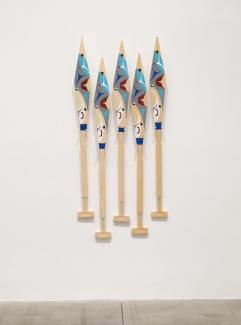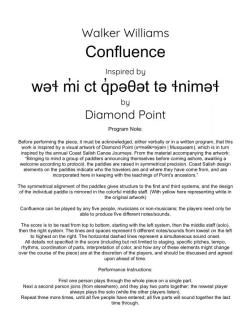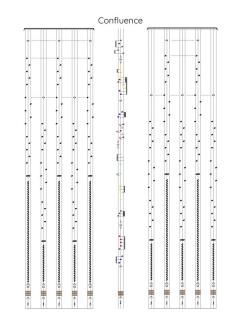Confluence
'Confluence' is a compositional response to wəɬ m̓i ct q̓pəθət tə ɬniməɬ, one of the pieces in the ‘Soundings’ exhibit. I was able to meet with the artist, Diamond Point, to discuss the composition, as well as the protocols that should be observed in its writing and performance. Since there is a long and problematic history of settler artists (such as myself) ‘borrowing’ from Indigenous artists, we both agreed it was important for the score (and any future performances) to be very clear about acknowledging the original work and its context. The hən̓q̓əmin̓əm̓ name wəɬ m̓i ct q̓pəθət tə ɬniməɬ carries the idea of a coming together, and since the artwork is based on traditions related to canoes and travel by water, I chose the name Confluence for my composition.

Diamond Point and Jordan Point, wəɬ m̓i ct q̓pəθət tə ɬniməɬ, 2018, cedar, paint. Collection of the artist. Installed at the Morris and Helen Belkin Art Gallery, University of British Columbia.
Photo: Rachel Topham Photography.
In exploring the gallery and looking for inspiration for a composition, Point’s work presented a few structural elements that were immediately translatable into sound/performance. The alternating high/low arrangement of the paddles, the gradual building up of the work over time (by additional paddles being added to the installation), and the structural importance of the number five were all used as building blocks of my composition. Additionally, in the spirit of decolonization, I wrote the piece in such a way as to circumvent some of the more problematic aspects of western classical music; the piece needs no conductor, and is written in a deliberately vague notation, reducing the amount of control I as the composer have over the performance. This helps mitigate the hierarchical roles of the composer and conductor in the western classical tradition, and places the artistic interpretation of the piece in the hands of the players collectively.
Visually, Confluence represents the design of wəɬ m̓i ct q̓pəθət tə ɬniməɬ. The alternating pattern of the paddles is visible in the first and third sections of the piece, with each staff representing one paddle. The individual notes in each staff create the outline of the paddle shape, while also being made of cells that are themselves iterations of the alternating pattern. The middle section represents the colour and design of each individual paddle.
The music is written on a three-line staff, allowing for five different note placements. These notes give an idea of relative pitch (left to right representing low to high) but do not represent specific pitches, leaving choice of pitches to the players. Rhythm is also roughly indicated but not specified. With the piece played on any five instruments or sound-makers and the interpretation of the various non-typical notations entirely up to the players, this means that the players have a very high degree of control over the actual sound of the piece, and every performance of Confluence will likely sound significantly different from any other performance.


The original plan was to premiere Confluence in person (likely outside) and share a video recording of that performance here, but due to safety concerns, the premiere live performance of Confluence has been postponed. In lieu of that performance, I’ve created a multi-track recording to give one idea of what the piece might sound like. Since the piece was to be performed outside, you’ll first hear the sound of the water (recorded on unceded Musqueam land at tower beach), followed by performances by myself (electronics), Alexander Marte (violin), Matheus Moraes (trumpet), Jocelyn Morlock (electronics), and Danny Wright (found percussion).

Walker Williams is an eclectic composer from rural West Virginia, whose compositional style runs the gamut from conservative tonality to avant-garde performance art (admittedly with an overall tendency towards writing ‘pretty music’). Walker is currently pursuing doctoral studies in composition at the University of British Columbia (UBC), and he holds a MMus in composition from UBC, and a BA in music composition from Shepherd University in West Virginia.
As a white settler, Walker has benefitted from the ongoing act of colonization in both the United States and Canada, and would like to acknowledge that his upbringing and education has taken place primarily on the homelands of the Massawomeck, Manahoac, and Musqueam nations.